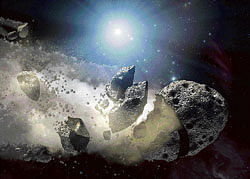
In recent times, two asteroids have been named after Indian scientists, Bhattacharya and Goku Menon. These innumerably present minor members of the solar system are now being discovered at an ever increasing rate.
The very first asteroid was discovered by Piazzi on January 1, 1801 and named Ceres. It is still the largest asteroid known and now qualifies as a minor planet along with Pluto. Soon three more of the larger asteroids were discovered, mainly by Olbers. They include Vesta (the only asteroid visible to the naked eye), Pallas and Juno.
In 1868, the hundredth asteroid, Hekate was discovered. Max Wolf pioneered the photographic technique and in 1891, made the first photographic discovery of asteroid, 323 Brucia and the first Jupiter Trojan asteroid, 588 Achilles.
This technique rapidly increased the number of newly discovered asteroids and by the year 1921, the thousandth asteroid Piazzia was discovered. In the next 60 years, i.e., by 1981, the ten thousandth asteroid, Myriostis was identified. By the year 2000, at the start of the new millennium, the number of asteroids had increased to one lakh, the hundred thousandth one being called Astronautica! In the past eight years, ie from 2000 to 2008, the number of discovered asteroids has increased by a factor of nearly five. By November 2007, a grand total of 387,205 new objects (nearly four lakhs!) had been designated.
Hundred and going strong
An individual astronomer, Peter Birtwhistle, from England has discovered more than hundred asteroids. His hundredth discovery, that of the main belt asteroid, 2008GE3 was made on April 7, 2008 and two days earlier, he had discovered two other asteroids.
Several asteroids (well over a hundred) are now known to be binaries and some of them rotate rapidly with a period of just three hours. Pluto, now reclassified as a dwarf planet, has been assigned the number 134,340. It is now only one of several almost equally large bodies beyond Neptune, the so-called Trans Neptunain Objects (TNO), which now numbers nearly a thousand and come in all sizes, colours and shapes.
For 57 years, 944 Hidalgo, was the only known asteroid object to travel beyond Jupiter’s orbit, until in 1977, Charles Kowal discovered Chiron, orbiting between Saturn and Uranus. Around 50 objects have been found which orbit further from the sun than Jupiter, yet closer than Neptune. These objects are classified as Centaurs, an appropriate name as several of them behave as ‘half-comet’ and ‘half-asteroid’. During the 1990s, the first of the TNO was discovered, 1992QB, called cubewanos and plutinos which have a 3:2 mean motion resonance with Neptune.
There are other categories also like the scattered disc objects (SDO) first of which was found in 1996 and asteroid families like Hirayama.
Near Earth Objects
Another class of asteroids which are of much interest are ones which come close to the earth, so called Near Earth Objects (NEO). The earliest example was 1937 UB Hermes, first sighted in October 1937. Almost one kilometre in diameter, it is the largest object known to have passed within twice the moon’s distance from earth. It again passed by five years later. Given its size and high velocity (>20kms) it packs the potential to cause massive devastation if it strikes the earth.
On October 15, 2003, it was again identified by the LONEOS search and was revealed to be a binary asteroid, with two objects (half a kilometre across each) separated by barely a kilometre with an orbital period of 14 hours.
In all, 68 objects are known to have passed within the moon’s orbit, many detected after reaching perigee. No object has been found to be on a collision course with the earth. Apophis is expected to come within 30,000 km of the earth in April 2029, but it is only thirty metres across. We may recall that in 1994, pieces of comet Shoemaker-Levy collided with Jupiter. Fragment G, which had a diameter of three km impacted Jupiter at 60km/s. The energy released was equivalent to a Hiroshima bomb exploding every second continuously for ten years.
One such asteroid which hit the earth in the Cretaceous period, 65 million years ago, wiped out the dinosaurs causing large scale extinction. The frequency of such a collision is once in a hundred million years. There are dedicated telescopes monitoring the NEOs and more than a thousand, greater than a kilometre across, is identified. There have been several suggestions for methods to deflect such asteroids if found to be on a collision course. The XuYi observatory in China, with its new one metre telescope has discovered over three hundred asteroids in the past one year. New large telescopes planned like the LSST are expected to find few more lakhs of asteroids.
(The author is with the Indian Institute of Astrophysics)